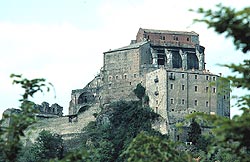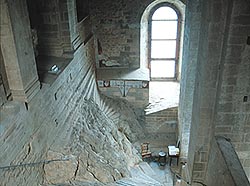L'Abbazia di San Michele della Chiusa

La Sacra di S. Michele sorge sulla sommità del monte Pirchiriano a 962 metri di quota in una posizione straordinariamente dominante sull'imbocco della valle di Susa, che ne fa uno dei più suggestivi monumenti medioevali delle Alpi.
Secondo la tradizione l'abbazia venne fondata nel X secolo dal santo eremita Giovanni Vincenzo, già vescovo di Ravenna, che si era ritirato in solitudine alle pendici del monte Civrari, sull'altro lato della valle. Sarebbero stati gli angeli e l'arcangelo Michele, apparsigli in sogno, ad indicare la cima del Pirchiriano come luogo per la costruzione di una chiesa.
In realtà la fondazione dell'abbazia, avvenuta tra il 983 e il 987, è attribuita dagli storici al conte alverniate Ugo di Montboissier. Questi donò ai monaci il monte e le terre circostanti. Anche il marchese Arduino concesse al monastero beni situati in varie zone della Marca di Torino. I possedimenti si andarono poi estendendo in tutta l'Europa meridionale, soprattutto in Francia dove arrivò a contare sino a 150 dipendenze. Ampiamente protetta dal papato, l'abbazia sfruttò questo privilegio nei ricorrenti contrasti con il vescovo di Torino.
Meta preferita dei pellegrini più facoltosi che nei loro viaggi a Roma vi trovavano una degna ospitalità, la Sacra si poneva inoltre come tappa centrale di un grande itinerario religioso che attraversava diametralmente l'Europa da San Michele sul Gargano a Mont St-Michel in Normandia.
Lo splendore del monastero durò fino al XIII secolo, a cui seguì una progressiva decadenza, forse dovuta alla difficoltà di amministrare un patrimonio così disperso. Nel 1381 l'abbazia cessò di essere un ente autonomo e passò sotto il protettorato di Amedeo VI di Savoia; da allora essa fu retta da abati commendatari fino alla definitiva soppressione del 1622. Nel 1836 il monastero venne riaperto da re Carlo Alberto e affidato ai Padri Rosminiani, che ancora vi risiedono.
Nel 1886 un terremoto minò le già compromesse strutture rendendo improcrastinabili le imponenti opere di consolidamento e restauro che, iniziate sotto la direzione di Alfredo d'Andrade, si protrassero fino al 1936.
Superato tramite la porta di ferro ciò che resta della cinta difensiva, con una lunga scalinata si accede all'ingresso e da qui allo "scalone dei morti", culminante nel portale dello zodiaco, capolavoro dell'arte romanica del XII secolo. Da qui si accede ad uno dei terrazzi e, tramite un'altra scalinata, all'ingresso della chiesa abbaziale, preceduta da un altro portale romanico. La chiesa è a tre navate terminanti in tre absidi; essa testimonia stilisticamente il passaggio dallo stile romanico al gotico. Notevoli sono i capitelli delle colonne e le altre sculture dell'abside centrale. Molti sono gli affreschi del XV e XVI secolo sulle pareti. Sull'altar maggiore è esposto un celebre trittico di Defendente Ferrari (XVI secolo). La chiesa contiene anche le tombe di ventiquattro principi di casa Savoia. Tramite una scaletta si accede poi alla sottostante cripta.
|
The St. Michael of the Chiusa Abbey

The Sacra (Holy) of S. Michael abbey rises on the top of the Pirchiriano mount at 962 meters of altitude in an extraordinarily dominant position on the entrance of the Susa valley. It is one of most evocative medieval monuments of the Alps.
According to the tradition the abbey was founded in the X century by the hermit Saint Giovanni Vincenzo, yet bishop of Ravenna, then retired in hermitage on the slopes of the Civrari mount, on the other side of the valley. The angels and the archangel Michele appeared to him in a dream and indicated the top of the Pirchiriano mount like the place to build a church.
In reality the foundation of the abbey, happened between 983 and 987: it is attributed by the historians to the Count Ugo of Montboissier. He donated to the monks the mount and the surrounding lands. Also the marquis Arduino granted to the monastery properties situated in the Turin County. The estates were then extending in all southern Europe, above all in France where reached 150 dependencies. Completely protected by the papacy, the abbey took advantage of this privilege in the recurrent contrasts with the bishop of Turin.
The abbey was the preferred destination of the rich pilgrims founding during their travels to Rome a worthy hospitality. The "Sacra" was moreover like a central stage of a great religious route diametrically crossing Europe from Saint Michele of the Gargano to Mount St-Michel in Normandy.
The splendour of the monastery lasted until the XIII century, to which a progressive decadence followed, perhaps due to the difficulty of administrating a so widely dispersed patrimony. In 1381 the abbey ceased to be independent and passed under the protectorate of Amedeo VI of Savoy; the definitive abolition was in 1622. In 1836 monastery was reopened by King Carlo Alberto and committed to the Rosminiani Fathers, still now residing.
In 1886 an earthquake mined the yet compromised structures and imposed no possibility of delay to the consolidation and restoration works, which were undertaken under the direction of Alfredo d' Andrade, lasting till 1936.
Passing through an iron door which is what remains of the defensive town-walls, we can reach through a long stairway the Abbey entering, and the so-called "great stairway of the dead men", culminating in the Zodiac Portal, masterpiece of the Romanesque art of the XII century. From here we can reach one of the terraces and, through an other stairway, the entering of the abbey church, preceded from another Romanesque portal. The church has three naves, ending in three apses; it stylistically testifies the passage from the Romanesque style to the Gothic one. The capitals of the columns and other sculptures of the central apse are remarkable. There are also many frescoes of the XV and XVI century. On the major altar a famous triptych of Defendente a Ferrari (XVI cent.) is exposed. The church contains also the tombs of twenty-four Savoy house princes.
|